An evolutionarily conserved cyclin homolog from Drosophila rescues yeast deficient in G1 cyclins
- PMID: 1833067
- PMCID: PMC2753436
- DOI: 10.1016/0092-8674(91)90043-x
An evolutionarily conserved cyclin homolog from Drosophila rescues yeast deficient in G1 cyclins
Abstract
We have isolated two Drosophila cDNA clones that rescue Saccharomyces cerevisiae deficient in CLN functions. One of these clones is the Drosophila homolog of the cdc2 gene. The second encodes a distant and new member of the cyclin family of proteins, cyclin C. It is highly homologous (72% identity) to a human clone isolated in a similar screen. Yeast cells rescued by a plasmid constitutively expressing this Drosophila cyclin C are unusually small, consistent with an unregulated high level of G1 cyclin function. Sequence comparisons identified regions conserved among the more distantly related cyclins. Based on these conserved elements, we identified homology between cyclins and the ras oncogene.
Figures

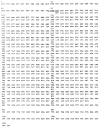
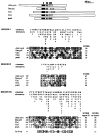

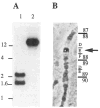
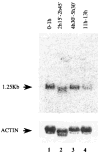
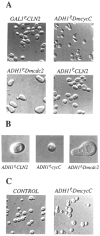
Similar articles
-
Isolation of three novel human cyclins by rescue of G1 cyclin (Cln) function in yeast.Cell. 1991 Sep 20;66(6):1197-206. doi: 10.1016/0092-8674(91)90042-w. Cell. 1991. PMID: 1833066
-
Human cyclin E, a new cyclin that interacts with two members of the CDC2 gene family.Cell. 1991 Sep 20;66(6):1217-28. doi: 10.1016/0092-8674(91)90044-y. Cell. 1991. PMID: 1833068
-
A novel cyclin gene from Drosophila complements CLN function in yeast.Genes Dev. 1991 Dec;5(12A):2166-75. doi: 10.1101/gad.5.12a.2166. Genes Dev. 1991. PMID: 1836192
-
G1-specific cyclins: in search of an S-phase-promoting factor.Trends Genet. 1991 Mar;7(3):95-9. doi: 10.1016/0168-9525(91)90279-Y. Trends Genet. 1991. PMID: 1827691 Review.
-
Plant cyclins: a unified nomenclature for plant A-, B- and D-type cyclins based on sequence organization.Plant Mol Biol. 1996 Dec;32(6):1003-18. doi: 10.1007/BF00041384. Plant Mol Biol. 1996. PMID: 9002599 Review.
Cited by
-
Functional analysis of the Ume3p/ Srb11p-RNA polymerase II holoenzyme interaction.Gene Expr. 1999;8(1):43-57. Gene Expr. 1999. PMID: 10543730 Free PMC article.
-
A tissue-specific coactivator of steroid receptors, identified in a functional genetic screen.Mol Cell Biol. 2000 Apr;20(7):2411-22. doi: 10.1128/MCB.20.7.2411-2422.2000. Mol Cell Biol. 2000. PMID: 10713165 Free PMC article.
-
Orphan kinases turn eccentric: a new class of cyclin Y-activated, membrane-targeted CDKs.Cell Cycle. 2012 Oct 15;11(20):3758-68. doi: 10.4161/cc.21592. Epub 2012 Aug 16. Cell Cycle. 2012. PMID: 22895054 Free PMC article. Review.
-
Identification of the domains in cyclin A required for binding to, and activation of, p34cdc2 and p32cdk2 protein kinase subunits.Mol Biol Cell. 1992 Nov;3(11):1279-94. doi: 10.1091/mbc.3.11.1279. Mol Biol Cell. 1992. PMID: 1333843 Free PMC article.
-
Exploitation of the Mediator complex by viruses.PLoS Pathog. 2022 Apr 21;18(4):e1010422. doi: 10.1371/journal.ppat.1010422. eCollection 2022 Apr. PLoS Pathog. 2022. PMID: 35446926 Free PMC article. No abstract available.
References
-
- Burgers PM, Percival KJ. Transformation of yeast spheroplasts without cell fusion. Anal Biochem. 1987;163:391–397. - PubMed
Publication types
MeSH terms
Substances
Associated data
- Actions
Grants and funding
LinkOut - more resources
Full Text Sources
Other Literature Sources
Molecular Biology Databases
Miscellaneous

